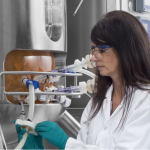
Gamma irradiation is being supplemented with alternative technologies.
Single-use (SU) technologies increasingly find use today at all phases of the drug development cycle from preclinical to commercial manufacturing. As the biopharmaceutical market continues to expand and reliance on single-use manufacturing rises, demand for SU consumables—bags, containers, filters, tubing, etc.—is also increasing. The value of the global SU consumables market has already reached several billion dollars and is predicted by multiple market-research firms to continue to expand at a compound annual growth rate of 16–18% for at least the next several years (1–3). A key driver for that growth is the fact that SU consumables come pre-sterilized and ready-to-use, making setup and changeover from one product to another much quicker and easier. Staying abreast of and managing trends in sterilization of SU consumables is therefore essential for biologics producers.
Several sterilization process essentials
Contamination poses a huge risk to the production of biologic drug substances and drug products, making sterility assurance imperative, states Christy Eatmon, global subject matter expert, sterile drug products in the Pharma Services business of Thermo Fisher Scientific. Processes used for the sterilization of SU consumables play an important role in enabling biopharmaceutical manufacturers to ensure sterility.
The main techniques include ionizing radiation (gamma-, electron-beam [e-beam]-, X-ray), gas exposure (ethylene oxide [EtO], vaporous hydrogen peroxide [VHP]), and heat/steam.
The first step in establishing an effective sterilization process for SU consumables, according to James Hathcock, senior director of regulatory and validation strategy at Cytiva, is to select a sterilization process that is compatible with the materials used in the construction of the SU components. “For instance, most bags are not compatible with heat sterilization, and SU consumables composed of some fluoroplastics (e.g., polytetrafluoroethylene and fluorinated ethylene propylene) will experience more degradation by ionizing radiation,” he says.
Controlling the sterilization process so that it delivers a sufficient minimum dose over the entire surface of the component to kill microbes and render the SU system sterile is also crucial, Hathcock observes. Typically, meeting a minimum 10-6 sterility assurance level with a dose that does not exceed an established value so as not to adversely impact or meaningfully degrade the materials is involved.
The requirements for sterilization by ionizing radiation, which includes gamma, X-ray, and e-beam, are all well defined by the ISO 11137 standard series, notes Hathcock. “These standards explain how the dose range is established, how to ensure each SU consumable/system receives the targeted dose range as part of the routine process, and how to verify the continued effectiveness of the sterilization process over time,” he says. The standards also, Hatchcock adds, provide guidance on how to migrate from one technology, such as gamma, to another, such as X-ray.
Hathcock goes on to point out that not all SU components and systems are irradiated with a sterile claim in accordance with ISO 11137. Some may be provided to a biomanufacturer without being irradiated or having been irradiated to minimize bioburden risk but without any claim of sterility. “It is therefore paramount that manufacturers be aware of the sterilization state of any SU consumables they receive,” he emphasizes. Generally, documentation is provided with each component/system.
Three key trends: capacity, complexity, and process control
The increasing use of SU technologies for biologic drug manufacturing has led to the biggest recent trend related to sterilization of SU consumables, which, Eatmon says, is to investigate other means of sterilizing SU assemblies and qualify alternative or multiple sterilization strategies for product contact surfaces other than gamma irradiation alone. Ensuring the security of sterilization supply is, agrees Hatchcock, the first and foremost important trend.
One of the drivers, according to Eatmon, is that as SU systems are increasingly implemented, the compatibility with gamma-irradiated surfaces has become a concern for some products with sensitivities to residual peroxides. Another is related to the available capacity for sterilization of SU consumables using widely established processes. “As EtO and gamma irradiation, the principal methods used today, have a limited supply capacity, concerns persist that regulation changes, newsworthy events, and supply-chain constraints could easily disrupt these services and thereby impact the flow of critical materials required for patient therapies,” Hathcock contends.
The challenge is to ensure supply exists in the face of swings in market demand and the limited ability to switch sterilization methods for devices that have already been validated using a specific sterilization modality, Hathcock observes.
The desire to streamline the process for sterility validation without compromising risk is a second important trend. Sterilization validation practices for SU consumables used in biopharmaceutical manufacturing grew out of established practices in the medical device world. There are, as a result, according to Hathcock, additional challenges when managing the often large and complex assemblies required to be tested on a quarterly basis for each SU manufacturing site.
“Evolving technologies in digital modeling and dose-delivery mapping during the irradiation process are expected to help optimize the process. In silico techniques can model how boxes of SU systems are positioned in pallets during irradiation, how many times they may need to pass in front of the irradiation field, and how realistically they could be moved from one irradiation technology to another—for instance gamma to e-beam,” Hatchcock notes.
On the regulatory side, another important trend revolves around growing expectations from regulators for biopharmaceutical manufacturers to better understand the control of irradiation processes rather than just trusting the supplier-provided certificate of quality claiming sterility for SU consumables. The driver behind this trend stems back to a Form 483 issued by FDA (4) indicating that the pharmaceutical manufacturer may not have understood or challenged the statement on a supplier certificate stating a bag was sterile and endotoxin-free, Hathcock says.
“Some manufacturers have interpreted this story as a need to perform their own sterility testing on incoming goods,” Hathcock observes. “If a manufacturer were to perform its own testing, however, an enormous and unrealistic number of incoming goods would have to be tested to achieve statistical significance. It is highly unlikely manufacturers are going to pursue this strategy. Instead, education as to how the sterilization process is managed and controlled via ISO 11137 is key,” he explains.
Reliance on gamma irradiation
Gamma irradiation has been and continues to be the method of choice for many SU consumables. “In most cases, gamma irradiation provides excellent assurance of sterility and good penetration for complex or multi-layer systems, where other methods might fail,” Eatmon observes. In fact, gamma sterilization via cobalt 60 has been used for the sterilization of medical materials since the early 1960s, according to Hathcock. “Much of its broader application to SU consumables grew from similar applications with transfusion sets and filters,” he comments.
“Gamma irradiation also has the advantage of being able to sterilize a wide variety of materials in the same cycle without requiring any moisture and it is good at sterilizing both internal and external surfaces of materials, which is a benefit for processes that require a high level of microbial decontamination,” Eatmon contends.
Alternative methods are considered, of course, when products may have compatibility challenges with gamma-irradiated materials, Eatmon remarks. However, with heat-dependent methods, Eatmon notes there may be a fine line between penetrating all surfaces while maintaining the integrity of the materials. In addition, while heat sterilization has been historically used for filters, connectors, and some tubing, it is not as simple to use as sterilizing by irradiation, says Hathcock.
EtO, meanwhile, is less ideal for SU systems intended to be functionally closed, because it is more difficult to ensure all surfaces are adequately exposed, according to Hathcock. He does point out, though, that there is a long history of EtO use in the medical device industry, with rich supporting data packages.
“While there have been some incidents with EtO that have caused concerns and misperceptions, with the use of science-based approaches, these issues can be properly mitigated to ensure a strong future for EtO,” Hathcock says.
VHP is used to frequently decontaminate exterior surfaces of SU systems such as in isolators, but is not amenable for sterilization of internal fluid paths.
E-beam sterilization is another form of ionizing radiation that uses a stream of electrons instead of photons to penetrate the packaging and materials of SU consumables. “Due to their mass and charge, electrons are not as effective at penetrating the materials used to make SU consumables; and therefore, it is more difficult to deliver a controlled dose to a large, complex, SU assembly,” Hathcock comments. He adds, though, that e-beam is gaining attraction for some smaller, less-complex SU consumables given that it is a similar ionizing radiation technology to gamma irradiation yet has a lower electricity cost.
X-ray irradiation has been well-recognized as a sterilization method, with a site intended for low-dose food irradiation opening in the United States in approximately 2001, according to Hatchcock. This site was later relegated to irradiation of government mail following the 2001 anthrax scare (5). The first X-ray site for commercial sterilization of medical devices was opened in 2010 by Synergy Health in Daniken, Switzerland, and since then the accelerator technologies supporting X-ray (and e-beam) have considerably matured. “Even so, given that gamma irradiation is well established with multiple contract irradiation sites located around the world and the regulatory challenges and hurdles to switching sterilization technologies, there has been little incentive to change,” he states.
Gamma-irradiation capacity concerns?
Increasing use of SU technologies has driven rising demand not only for SU consumables, but for sterilizing services. This rise in demand is occurring at a time when the supply of 60Co (used to produce gamma rays) has been challenged due to decommissioning and refurbishment of many nuclear plants where 60Co is generated from 59Co (6). Addition of new gamma irradiation sites, meanwhile, is extremely difficult (7,8).
Establishing ideal, well-understood models of supply and demand for gamma-irradiation services has been complex in recent years. In addition to the perceptions of 60Co availability, spikes in demand during the COVID-19 pandemic impacted assessments, according to Hathcock.
“As a single-use supplier, much of our supply assessment is based on the short- and long-term contract negotiations with a range of different irradiators, where we and other single-use suppliers observed a continued tightening in the gamma irradiation market. With the end of COVID-19 and internal efforts for how and where we manufacture and irradiate single-use goods, we have been able to manage the capacity challenge and are expecting the critical need to hit sometime in mid to late 2025,” Hathcock says.
Hathcock adds that the specific timelines may vary by supplier, region, and SU portfolio and will depend strongly on order forecast models as well as contracts with irradiators.“From a security-of-supply perspective, to ensure critical goods are available for patient therapies, it is certainly much better to be aware, prepared, and ahead of the curve as opposed to behind and surprised,” he concludes.
X-ray irradiation is an attractive alternative
X-ray technology has been explored and can offer lead-time advantages, according to Eatmon. She cautions, however, that as is often the case with new technologies, adoption can be a lengthy process due to additional validations required and the regulatory impact of making changes to existing processes.
X-ray irradiation is an attractive alternative because, like gamma irradiation, it is photon-based and thus kills microbes by the same mechanism. In addition, the technique has been used for the sterilization of medical devices for over a decade. The key difference between X-ray and gamma irradiation is in how the photons are generated. Even so, ISO 11137-1:2006 Sterilization of Health Care Products—Radiation—Part 1 treats the requirement for ionizing radiation including gamma, X-ray, and e-beam technologies equally (9).
The potential for supply challenges related to gamma irradiation impacts multiple regions. In addition, because the irradiation sterilization technology must be well-supported to address regulatory requirements for sterility, there is no way, says Hathcock, any one supplier or pharmaceutical manufacturer can tackle the issue alone.
“The industry therefore worked together through industry trade groups including the Bio-Process Systems Alliance (BPSA) and BioPhorum on a cohesive strategy for moving forward with X-ray that works for component manufacturers, integrators, pharmaceutical manufacturers, and regulators,” Hathcock remarks.
BPSA published background and risk-based testing strategies for SU systems in 2020 (10) and a second paper in 2023 sharing data on a variety of components from multiple suppliers and test labs all indicating an equivalent impact of X-ray as compared to gamma (11). BioPhorum, meanwhile, published in 2023 a risk-evaluation white paper illustrating a practical approach for evaluating the risks and supporting data from the perspective of the pharmaceutical manufacturer (12).
“It is likely,” Hathcock states, “that the SU bioprocess industry will move forward with X-ray irradiation together given the interconnectedness of SU component supply chains. Components such as sensors or tubing may be evaluated by the component manufacturer for X-ray compatibility, then provided to an integrator who assembles these components with others, and then manages the irradiation process before shipping to the end user.”
The medical device industry, according to Hathcock, also recognizes the value of working and publishing data supporting X-ray sterilization. As an example of a successful transition from gamma to X-ray sterilization, he points to the move made by Schott in 2012–2013 to implement X-ray sterilization of syringes (13).
Overcoming regulatory hurdles
As with all steps in the sterile drug manufacturing process, the sterilization of SU components must be validated. “To develop a new sterilization technique or even modify existing processes, a robust validation must be completed, including consideration of worst-case scenarios and challenging of all parameters,” Eatmon says. She does emphasize, though, that with proper validation packages, regulatory agencies should find these processes acceptable.
Building confidence that regulators are aware of X-ray and will support the BPSA and BioPhorum-aligned risk evaluation strategies has been a key focus for industry work groups, according to Hathcock. These groups have shared their experience with FDA’s Center for Drug Evaluation and Research Emerging Technology Team (ETT) and Center for Biologics Evaluation and Research Advanced Technologies Team (CATT), as well as the European Medicine Agency’s Quality Innovation Group (QIG) and Japan’s Pharmaceutical and Medical Devices Agency.
Many of the agencies have sent representatives to industry conferences and workshops on X-ray sterilization and hence awareness is expected to be increasing. FDA representatives also plan to visit some of the X-ray and gamma irradiation sites in mid-2024 as part of their experiential learning program.
“All the agencies have been receptive to the transition from gamma to a dual-technology approach, in which SU systems can be gamma or X-ray treated, but the experience has varied from agency to agency,” Hathcock says.
One issue for some of the agencies relates to the use of the word “gamma” in existing filings. “While some health authorities are not focused on the use of the term given that both X-ray and gamma irradiation are identical in the fundamental photon technology used for sterilization, dose ranges employed, and impacts to the materials, others consider a move from gamma to X-ray sterilization as a potential technical discrepancy between what one practices and what is in the filing if gamma irradiation is specified in the filing but X-ray irradiation is used in practice,” Hathcock explains. This one hindrance, therefore, is not related to the scientific underpinnings of the technologies, but to the use of the term “gamma” instead of “ionizing irradiation” as described by ISO 11137.
Pursuing a dual-irradiation strategy
Going forward, the move to supplement gamma irradiation with other alternative technologies, most notably X-ray irradiation, will continue to be the main trend impacting the sterilization of single-use consumables, according to Eatmon. All the efforts made by the industry are pursued with the goal of ensuring there is an effective supply of sterilization capacity to support patient therapies, Hathcock adds.
“Education and communication about X-ray irradiation in combination with the adoption of dual irradiation technology approaches for sterilization of SU assemblies will be crucial to achieving this goal,” Hathcock contends. “Such a strategy,” he believes, “will allow the biopharmaceutical industry to continue to use the existing, well-established, and extensive gamma-irradiation capacity as an ongoing key part of the solution while also enabling operational flexibility to use mature accelerator-based forms of irradiation technology to meet the growing market demand for increased sterilization capacity.”
Reference
- The Business Research Company. Single-Use Consumables Global Market Report 2024. January 2024. https://www.thebusinessresearchcompany.com/report/single-use-consumables-global-market-report
- Precedence Research. Single-Use Consumables Market. Precedenceresearch.com. https://www.precedenceresearch.com/single-use-consumables-market
- MarketsandMarkets, Single-Use Consumables Market Worth $4.7 Billion by 2027. Press Release, https://www.marketsandmarkets.com/PressReleases/single-use-consumable-market.asp
- FDA. Form 483 to Biogen Idec Inc., Aug. 2, 2013. https://www.fda.gov/media/87315/download
- United States General Accounting Office. Diffuse Security Threats: Technologies for Mail Sanitization Exist, but Challenges Remain. Report to Congressional Requesters, April 2002. https://www.gao.gov/assets/gao-02-365.pdf
- Comben, M. Viewpoint: The Critical Production of Cobalt-60 in Nuclear Reactors. World Nuclear News, March 28, 2023. https://world-nuclear-news.org/Articles/The-critical-production-of-cobalt-60-in-nuclear-re
- Canadian Nuclear Safety Commission. Security of Nuclear Substances: Sealed Sources REGDOC-2.12.3. Ottowa, 2013.
- Chou, J.; Skornicki, M;. and Cohen, J. Unintended Consequences of the Potential Phase-Out of Gamma Irradiation, F1000Research 2018 7:346.
- ISO. 11137-1:2006, Sterilization of Health Care Products–Radiation–Part 1: Requirements for development, validation and routine control of a sterilization process for medical devices.
- BPSA. X-Ray Sterilization of Single-Use BioProcess Equipment, Part 1: Industry Need, Requirements & Risk Evaluation. Technical Guide, May 17, 2021. https://www2.bpsalliance.org/forms/store/ProductFormPublic/x-ray-sterilization-of-single-use-bioprocess-equipment-part-1-industry-need-requirements-risk-evaluation
- BPSA. X-Ray Sterilization of Single-Use BioProcess Equipment, Part II: Representative Qualification Data. Technical Guide, July 11, 2023. https://www2.bpsalliance.org/forms/store/ProductFormPublic/x-ray-sterilization-of-single-use-bioprocess-equipment-part-2
- BioPhorum. Guidance for Risk Evaluation of X-ray Irradiation of Single-use Systems (BioPhorum, Sept. 22, 2023). https://www.biophorum.com/download/guidance-for-risk-evaluation-of-x-ray-irradiation-of-single-use-systems/
- Jaeger, B. “Gamma to X-Ray: Experience and Approach at SCHOTT,” Presentation to BioPhorum members, April 28, 2021.
About the author
Cynthia A. Challener, PhD, is a contributing editor toBioPharm International.
Article Details
BioPharm International
Volume 37, No.7
July/August 2024
Pages: 22-27
Citation
hen referring to this article, please cite it as Challener, C. A. Sterilization Trends for Single-Use Consumables. BioPharm International 2024 37 (7).





